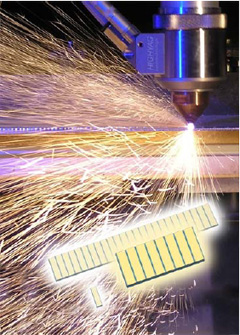The new generation of mini laser bars from OSRAM Opto Semiconductors offers exceptional brilliance in the wavelength range from 910 to 1020 nm. Their output and beam parameters have been closely matched to one another so that the enormously powerful light beam, which leaves the small laser aperture at a defined angle, can be perfectly coupled into a small fiber core diameter with a restricted acceptance angle. Sampling will start immediately; series production will start at the beginning of 2010.

The brilliance of a laser is a measure of the output per unit area and solid angle, and defines how much light from a mini laser bar can be efficiently injected into a glass fiber. The high brilliance of this new laser bar has been achieved by the new VLOC epitaxial structure (Very Large Optical Cavity) and new proprietary mirror coating technology. Dr. Jörg Heerlein, Head of Laser Product Marketing at OSRAM Opto Semiconductors, commented: "Our new mini bars have a high optical output and efficiency, which enables us to offer tailor-made solutions for cost-effective fiber-coupled laser diodes."
Mini laser bars also combine the advantages of single emitters with those of classic 1 cm bars. They are cost-effective, durable and can be easily adapted to meet the requirements of different applications thanks to their small size. In contrast to conventional fiber-coupled diode laser systems, the new bar structures allow more cost-effective beam-forming concepts to be used for fiber coupling. The associated reduction in system costs is a major factor in making diode laser systems more attractive for direct material processing - particularly in comparison with alternative laser solutions.
Brilliant mini laser bars are available in various application-specific product families, with fill factors of 10 to 20% and typical efficiencies of up to 65%. In addition to pumping fiber lasers, the laser bars are also used for direct micro-material processing, such as marking and micro-welding.
The brilliance of the mini laser bars is exemplified by the SPL BF series. It has a fill factor of 10% and provides an output of 8 W per emitter at an emitter width of 100 µm, with a slow-axis divergence of < 7° (the value applies to 95% output). The maximum output compatible with long life is around 12 W per 100 µm emitter. With five emitters the beam parameter product is 15 mm x mrad. With the aid of simple optics, the light from several mini laser bars can be coupled into a fiber with a core diameter of 200 µm and a numerical aperture NA of 0.22. In this way, outputs from the fiber in excess of 200 W can be achieved. Depending on customer requirements, numerous further designs and specifications can be produced on the basis of the new technology.
New technology concepts for increased diode laser brilliance are currently developed in the research project "HEMILAS" - funded by the German Ministry of Education and Research within the INLAS concept (FKZ 13N9575).